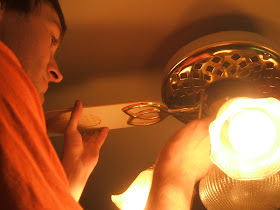So we did so much work building a fence for this puppy, so we might as well show him off!
Here he's about 2 months:
And at 5 months...
Sunday, February 19, 2012
New ceiling fans!
We wanted to update our ceiling fans, as they were a horrible gold/brass finish with cane blades. First we began by removing the blades from the old ceiling fan. Now, FLIP THE BREAKER and ensure no power is going to the fan.
We unscrewed the fan from the ceiling mount, and took a quick picture before disconnecting. This is EXTREMELY helpful for our house, which has some of the weirdest wiring I could imagine.
Next we screwed the ceiling assembly to the ceiling mount. One of us held it in place while the other inserted the screws.
Next, we attached the lights, the blades, and flipped the power back on. Voila!! There is light.
How to Build a Chain Link Gate
So pretty much, we screwed up. Even though we measured over and over again, when we had actually finished concreting in the gate posts for our gate, the gate posts were too far apart. So, we had to figure out how to build one custom gate.
First we had to build the frame. We did this by purchasing top rails. Ours were 1 3/8 inch in diameter. We measured very carefully, and cut them to size. Below is a diagram displaying how we calculated how long our rail segments had to be. We needed our gate to be 51" in width. By testing the elbow pieces and seeing how far we could shove the elbow pieces onto the rails, we calculated that because the elbow pieces added 2 inches onto the length, our segment needed to be four inches shorter than our 51" width. Follow the same procedure for the gate length, and keep in mind the total high should be about one inch shorter than your fence height, so the gate is able to swing without touching the ground. Ours measured 47" tall for a 48" fence.
Here I am assembling the frame.
Here's a close up of the gate elbow.
Then we used gate hardware to put the gate in place.
We proceeded to attach the fencing to one end of the gate using 1 3/8" tension bands, stretch it to the other, and attach at that end.
And we have a gate! We still need to trim the top off of the chain link fencing, but for now that's just a cosmetic consideration. Our puppy can now run around!
First we had to build the frame. We did this by purchasing top rails. Ours were 1 3/8 inch in diameter. We measured very carefully, and cut them to size. Below is a diagram displaying how we calculated how long our rail segments had to be. We needed our gate to be 51" in width. By testing the elbow pieces and seeing how far we could shove the elbow pieces onto the rails, we calculated that because the elbow pieces added 2 inches onto the length, our segment needed to be four inches shorter than our 51" width. Follow the same procedure for the gate length, and keep in mind the total high should be about one inch shorter than your fence height, so the gate is able to swing without touching the ground. Ours measured 47" tall for a 48" fence.
Here I am assembling the frame.
Here's a close up of the gate elbow.
Then we used gate hardware to put the gate in place.
We proceeded to attach the fencing to one end of the gate using 1 3/8" tension bands, stretch it to the other, and attach at that end.
And we have a gate! We still need to trim the top off of the chain link fencing, but for now that's just a cosmetic consideration. Our puppy can now run around!
Building a Fence
So we desperately wanted to get a puppy, but first wanted to build a fence so that our property was totally enclosed. It was about 80% enclosed when we got the place, but the fence would just start and end randomly. Below is the before pictures. There is a gate present, but it attaches to nowhere. We used the information from the Lowe's website. http://www.lowes.com/cd_Install+a+Chain+Link+Fence_588388906_
So first we measured out where the fence would have to go, using string to keep a straight line. Then we used spray paint to mark where the holes for the line pots should go (ours were spaced about 9 feet apart). Andrew then used a post digger to dig the holes.
Then, we mixed up the cement in a wheelbarrow and poured the concrete around the post.
Here's what the post looked like. We let the concrete dry for 24 hours, making sure to cover the tops so that rain doesn't get inside to rust the line post. We used Seran wrap with a rubber band, because we hadn't purchased the post caps yet.
Next we assembled the top rails. These were from home depot, and were made to slide into eachother to make longer segments. We then had to saw it to size.
We placed line caps on the line posts, fittings on the corner posts, and attached the top rail.We then decided to attach wire to the bottom of the fence, to make it more difficult for a dog to dig under the fence.
Then we attached the fencing to one post, unrolled it, and cut it to length.
We inserted the tension bands, stretched the fence, and attached fittings.
Finished!
And here's the newest member of the family! With so much room to run around!






























